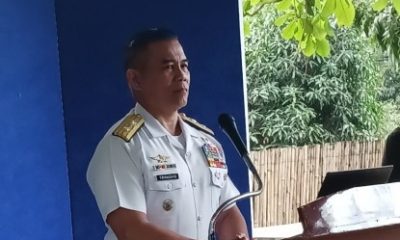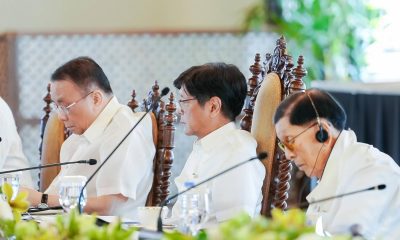News
Files show birth of Papua independence struggle

Papua New Guinea flag (Photo By Nightstallion, Public Domain)
JAKARTA, Indonesia — Prominent Papuans pleaded for the U.S. to give them money and arms in the mid-1960s to fight Indonesia’s colonization of their vast remote territory, according to recently declassified American files that show the birth of an independence struggle that endures half a century later.
The documents add to the historical evidence of deep Papuan grievances against Indonesia at a time when clashes between rebels and Indonesian security forces have flared in the impoverished region and Papuan nationalists have succeeded in drawing more attention to their cause at the United Nations. Indonesia’s defence minister said last week that activists who attended a recent pro-Papuan independence meeting in Vanuatu should be arrested on return to Indonesia.
The files are among the thousands of pages of cables between the State Department and the U.S. Embassy in Jakarta from the 1960s that were declassified earlier this year. The 37 boxes of telegrams are stored at the National Archives and Records Administration in Maryland and researchers are working on making them available online.
Papua, which makes up the western half of the giant island of New Guinea, remained in Dutch hands after Indonesia shook off colonial rule at the end of World War II. Many Indonesians saw their government’s campaign in the early 1960s to take Papua from the Dutch as the final victory in their struggle for independence. But to Papuans, with a Melanesian culture and history distinct from Southeast Asia, Indonesia was a hostile colonizer.
The rest of the world looked away as a rigged vote of a little more than 1,000 hand-picked and closely managed Papuans cemented Indonesia’s control in 1969. The Netherlands, which before annexation was preparing Papua for self-rule, did not object. The U.S., which in 1967 helped American mining company Freeport secure rights to exploit rich copper and gold deposits in Papua, did not want to upset a status quo favourable for U.S. business or destabilize Indonesia’s pro-U.S. government.
An April 1966 cable from the State Department recorded the “eloquence and intensity” of Markus Kaisiepo, an exiled Papuan leader, who spoke with a senior U.S. official about the “desperate plight of the Papua people under Indonesian rule.”
Kaisiepo said Papuans were determined to have independence but were completely without financial resources or the military equipment needed to “rise against the Indonesian oppressors.”
Kaisiepo, whose son would also become a prominent advocate for Papuan independence, asked if the U.S. “could provide money and arms secretly to assist him and his movement.” He was rebuffed, as was another Papuan leader, Nicolaas Jouwe, who made a similar request to the U.S. in September 1965 and also to Australia.
The documents also show how officials looted the region after Indonesia annexed it in 1962 and brought about a collapse in living standards, stoking anger that boiled over into outright rebellion. But the biggest source of resentment was Indonesia’s reluctance to honour its U.N.-supervised and U.S.-brokered treaty with the Netherlands, which mandated that Papuans would decide in a plebiscite whether to stay with Indonesia or become self-ruled.
After U.N. troops left Papua, Indonesians systematically looted public buildings and sent the booty to Jakarta, the April 1966 cable said, citing Kaisiepo. Hospitals built by the Dutch were stripped of beds, X-ray equipment and medicines, desks were taken from schools and soldiers stole anything “that took their fancy” from private homes.
Other cables citing American missionaries working in Papua described widespread food shortages, and how Indonesian officials bought up all consumer goods and shipped them out of Papua for a profit. When shipments of goods and food arrived at ports, Indonesian troops would commandeer them.
Victor Yeimo, chairman of the pro-Independence West Papuan National Committee, said the documents are “very important” because they provide evidence of crimes against Papuans by the Indonesian military and the U.S. role in denying self-determination. Administratively, Indonesia divides the region into two provinces, Papua and West Papua, but Papuans refer to both as West Papua.
“Information gained from these documents shows the world and today’s generation that the U.S. and Indonesia have been hand-in-hand in hiding the truth all along. The economic and political interests of the U.S. played a big role in West Papua’s colonization,” Yeimo said. “We, West Papuans, have been butchered since Indonesia first entered our land and up to now. And we have never seen any justice.”
Papuans were not without supporters in the U.S. Embassy in Jakarta but their views did not prevail. In August 1965, the embassy’s political officer Edward E. Masters recommended the department leak word of violent uprisings against Indonesia’s rule in Papua to the world press. Without the glare of publicity, Papuans would suffer “complete colonial subjugation” by Indonesia, he wrote in a prescient cable.
Citing the U.S. role in negotiating the 1962 treaty between the Netherlands and Indonesia, Masters wrote “we would appear to have a special responsibility to see that the terms of that treaty concerning ascertainment of the true wishes of the Papuan people are respected.”
Another cable written by Ambassador Marshall Green, however, described Papuans as “stone-age” people. Their “horizons are strictly limited,” it said, and they weren’t capable of deciding their own future, contradicting other assessments by the embassy of Papuans’ widespread desire for independence.
Word of violent uprisings, which began about March 1965, began trickling out of Papua as American missionaries who were working in the region visited Jakarta and embassy officials tapped sources in the Indonesian military for information.
In June 1965, rebels launched a full-scale attack on a government post in the town of Wamena that killed at least a dozen Indonesian soldiers and an unknown number of Papuans.
“No figure on the number of Papuans killed is available but one informant described it as a ‘slaughter,’ since almost the only weapons in the hands of the highland Papuans were knives and bows and arrows,” said a cable sent two months later.
The same document reported that rebels overran most of Manokwari, a major coastal town, in early August and held it for a week until beaten back by Indonesian soldiers.
A massacre by Indonesian forces the previous month may have been a catalyst for that attack.
A Dutch missionary told U.S. officials that rebels had shot three soldiers raising a flag in a valley near Manokwari in late July.
“Indo reaction was brutal,” said a cable transmitted in September 1965. “Soldiers next day sprayed bullets at any Papuan in sight and many innocent travellers on roads gunned down. Bitterness thus created not easily healed.”
By early 1967, there were persistent rumours within Indonesia and abroad that 1,000 to 2,000 Papuans had been killed by an Indonesian air force bombing campaign.
The Indonesian government denied it, asserting instead that 40 tribesmen were killed in “strafing” runs by an air force bomber in response to an ambush of paramilitary police, according to an April 1967 cable.
The number of police wounded in the ambush: two.






















Pingback: Files show birth of Papua independence struggle | Africa Report on Business